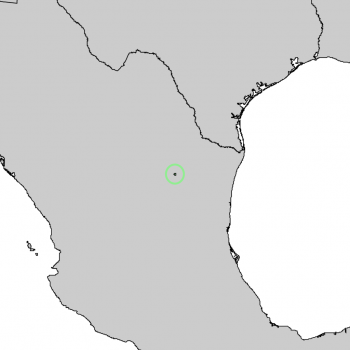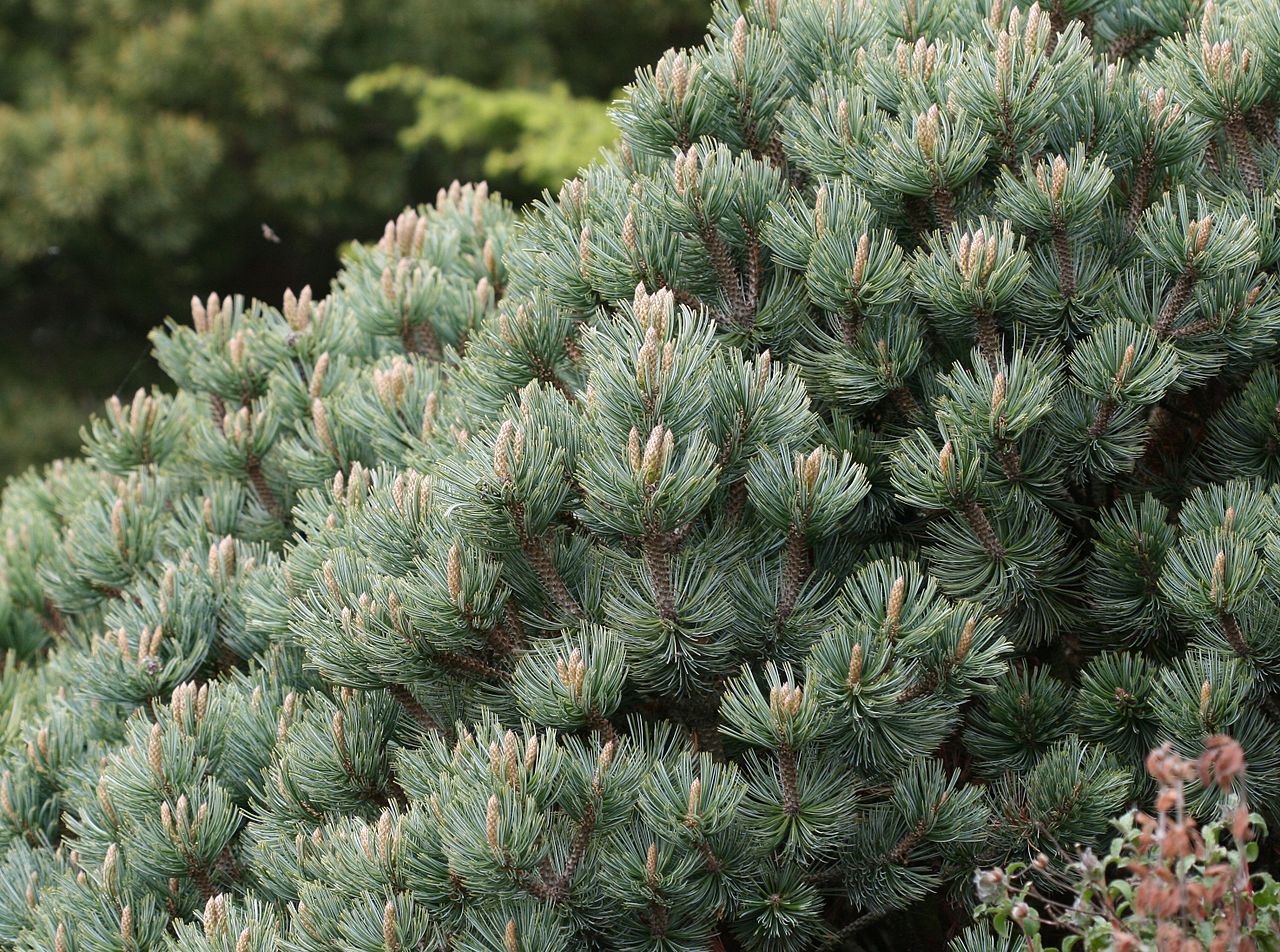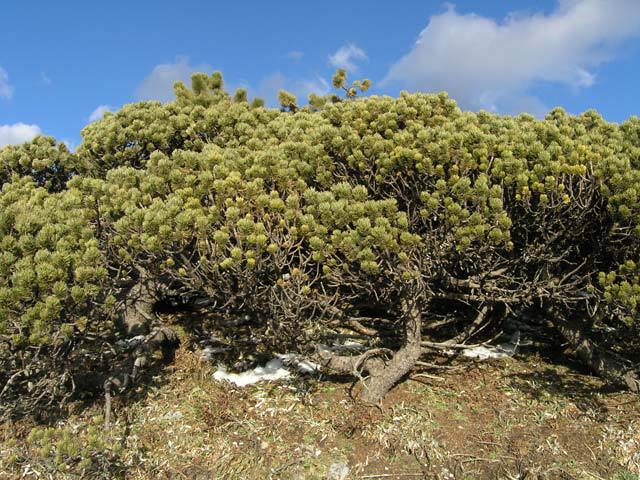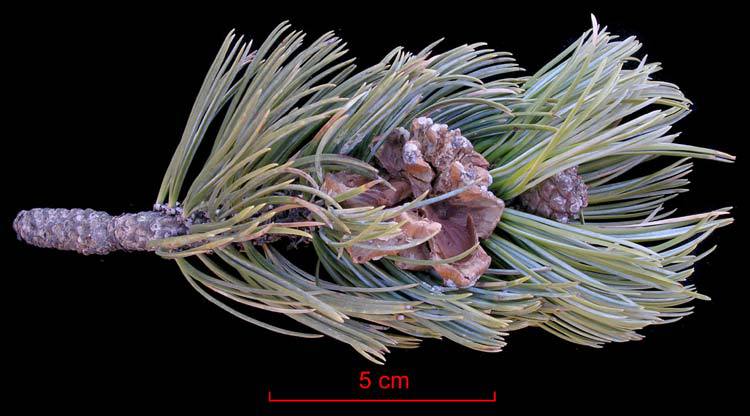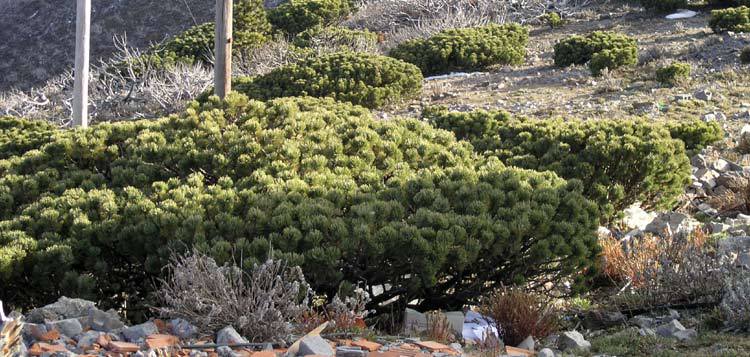subgenus Strobus (Lemmon), section (Parrya Mayr), subsection Cembroides (Engelmann).
Pinus culminicola, first described in 1961 by John W. Andresen and John H. Beaman is commonly known as Potosà piñon pine or Plateau pinyon. The specific epithet is Latin for "peak dweller," as this species grows at the highest elevations of any pine in the pinyon group as well as highest humidity.
Ethnobotany. This is perhaps the only piñon with no history of aboriginal use, as it grows at formerly uninhabited altitudes. Like the other piñons, it has edible seeds and no doubt the microwave station staff on Cerro Potosà now collect them for local use on occasion. It may also receive some use as firewood. With its very attractive Blue-green foliage, it is potentially a valuable slow-growing ornamental species for small gardens in cool dry areas, but it is still very rare in cultivation.
Description. Potosà piñon pine is a shrubby evergreen coniferous species of tree that grows to mature heights of 3 to 15 feet (1 -5 m) tall, with trunks up to 6 to 10 inches (15 - 25 cm) diameter, growing multi-stemmed or very low-branched, with a low, dense, rounded crown. It often forms extensive mats up to several feet (m) thick and tens of feet (m) across ("matorral").
- Bark is thin and scaly, with peeling shaggy grey-brown plates exfoliating to expose the fresh bright orange bark beneath (similar to P. johannis). Bark on young stems smooth and gray.
- Branches are numerous, the first-order branches often prostrate to assurgent, the higher-order branches assurgent to erect, short and thick, rigid but resilient, forming a dense, rounded to flat crown, usually matted with other individuals.
- Shoots are short, thick, rough; the bases of the bract leaves (pulvini) decurrent, persistent, light brown in color turning gray. Bract leaves small, narrowly triangular to subulate shape with a caudate apex and erose margins that are persistent in part, colored light brown, weathering blackish gray.
- Foliar buds are broadly ovoid shaped. The terminal buds measure 0.24 to 0.4 inch (6 - 10 mm) long, the laterals are smaller. All are slightly resinous with imbricate scales that are free at the apex. These scales are subulate-caudate shaped and colored light brown.
- Fascicle sheaths are initially 0.24 to 0.32 inch (6 - 8 mm) long, consisting of 4 to 6 imbricate, translucent, ciliate-margined scales. In mature fascicles, the scales separate to form a rosette at the base They are straw-colored to gray, semi-persistent but mainly falling before the leaf fascicles.
- Leaves (needles) are borne 5 to a fascicle (very rarely 4 or 6) and are retained on the tree for 2 - 3 years. They are obtuse; stiff, and curved toward the shoot apex. Needles measure 0.2 to 2 inches (3 - 5 cm) long and 0.36 to 0.52 inch (0.9 - 1.3 mm) thick with entire margins and stomata present on both adaxial surfaces. The abaxial surface is colored dark green and the adaxial surface glaucous with 4-5 stomatal lines on each leaf face.
- Pollen cones are borne crowded on the proximal part (circa half) of a new shoot, ovoid-oblong shaped when mature, measuring 0.2 to 0.32 inch (5 - 8 mm) long, colored yellowish, turning yellowish brown.
- Seed cones are subterminal, solitary or paired, sessile or on a stout, short peduncle covered with subulate-caudate cataphylls. Immature cones subglobose, resinous, colored purple-brown, and mature 2 years after pollination. Mature cones subglobose when closed, opening with a flattened base and remote, spreading fertile seed scales. At that point they are 1.2 to 1.8 inches (3 - 4.5 cm) long and 1.2 to 2 inches (3 - 5 cm) broad deciduous soon after shedding seed. Fully developed cones in the upper crown have 10 to 15 fertile scales; small cones from low branches (with poor pollination and nutrient supply) are often lopsided with 1 to 10 fertile scales.
- Seed scales number 45 to 60, parting and spreading wide except the smaller, infertile proximal scales. They are irregularly shaped, often curved, thin, coarsely wrinkled; colored orange-brown, with 1 to 2 deep, cup-like depressions holding the seeds, bordered by membranous seed wing remnants. Margins are irregular and erose, colored yellowish on both sides. Seed cups are brown. Apophysis is slightly raised, transversely keeled, rhomboid shaped, measuring 0.4 to 0.6 inch (10 - 15 mm) broad with a pointed apex. Umbo is dorsal, flat or slightly raised, rhombic in outline, dark brown or blackish in color, measuring 0.16 to 0.2 inch (4 - 5 mm) wide, with or without a minute prickle, and often resinous.
- Seeds are colored dark orange-brown, measuring 0.2 to 0.28 inch (5 - 7 mm) long and 0.16 to 0.2 inch (4 - 5 mm) broad, with a rudimentary 0.02 to 0.04 inch (0.5 - 1 mm) wing that remains in the cone upon seed release.
Distribution. This species is native to Mexico - the states of Coahuila and Nuevo León. It was first found in the summit area of Cerro Potosà in Nuevo León, 65 km west of Linares at 24.8729°N 100.2334°W. This is the most extensive-known population. Three or four small populations are also recorded on the high ridges about 50 km northwest of there on the Nuevo León-Coahuila border. It grows at elevations of 9,800 to 12,200 feet (2,965 - 3,700 m) above sea level on rocky and calcareous soils, the highest mean elevation of any pine. Since its current distribution includes only the highest elevations on summits within its range, it must be regarded as severely at risk of extinction due to global warming. Existing climate parameters are not well-known due to a lack of weather stations at these summits. Hardy to USDA Zone 7 - cold hardiness limit between 0° and 10°F (-17.7° and -12.2°C).
